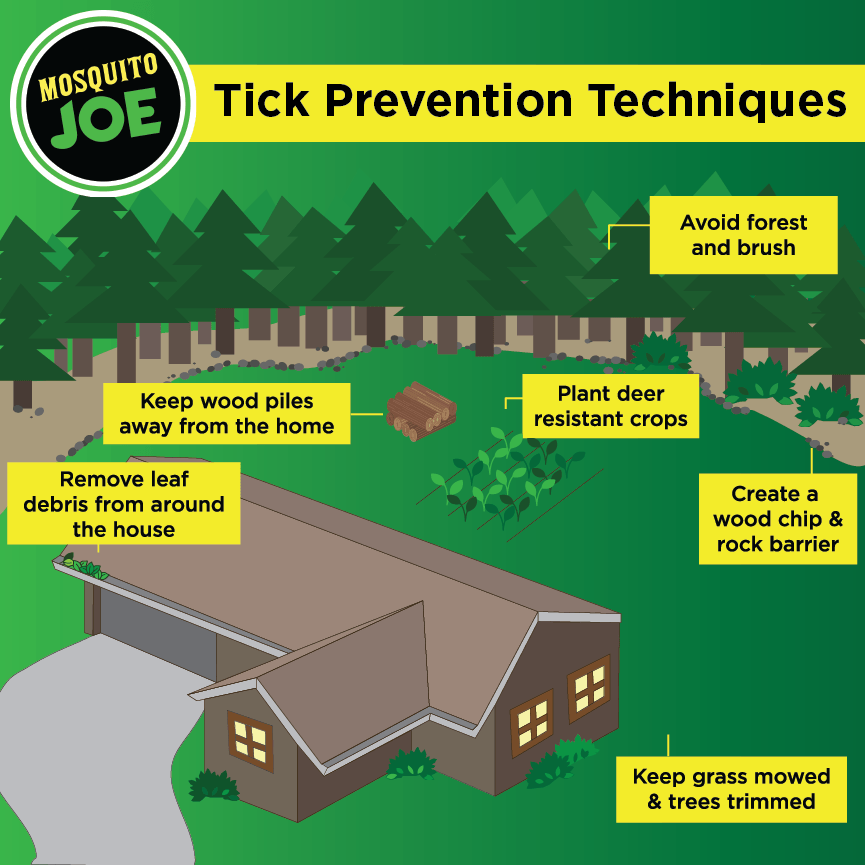With increasing evidence that ticks are capable of withstanding cold temperatures, these pests are becoming a year-round problem. Therefore, understanding the risks ticks pose and the best strategies to remove them are of great importance, even in the fall and winter months.
How to Prevent Against Tick Bites
- Know where ticks hide. Ticks live in tall grass and wooded areas. Hunting, gardening or spending time in your backyard are all activities where you, your family and your pets could pick up ticks.
- Dress to avoid ticks. Wearing long sleeves and long pants, tucking socks into boots and wearing light-colored clothing can help prevent tick bites.
- Utilize Mosquito Joe barrier treatments as an added layer of defense. Regular barrier treatments from Mosquito Joe eliminate ticks and give you and your family peace of mind.
 How to Check for Ticks
How to Check for Ticks
Ticks can be as small as the tip of a pencil. Because they like to hide in warm places, they’re usually hidden and are difficult to find. Check these places once coming back indoors to ensure you don’t have any lingering ticks.
- Under the arms
- In and around ears
- Inside the belly button
- Back of the knees
- In and around the hair
- Between legs
- Around the waist
Be sure to inspect outside gear and pets for ticks that could have latched on while outside. Additionally, throw clothing in the dryer for 10 minutes to remove ticks. Taking a shower within two hours of being outdoors will help wash off unattached ticks and decreases the chance of contracting a tick-borne disease.
How to Properly Remove a Tick
- Don’t panic! Grab a pair of tweezers with a fine tip. This will be the best tool to remove the small insect.
- Pull upward using steady, even pressure. Using this motion will ensure that the mouth-parts of the tick don’t break off and remain in the skin. If this does happen, use the fine-tipped tweezers to remove the mouth-parts.
- Clean the bite. Use rubbing alcohol or soap and water to clean your hands, the infected area and your tweezers.
- Dispose of the tick. Place the tick in alcohol, put it in a sealed container, wrap it in tape or flush it down the toilet. Don’t crush the tick between your fingers as it could still transmit disease.
- Following up: check on the bite. If you develop a rash, fever or any of the other symptoms associated with tick-borne disease, seek medical assistance. Tell your doctor about your recent tick bite, when the bite occurred and where you acquired the bite.
Know the Symptoms of Tick-borne Illness
There are numerous diseases that are caused by ticks. Knowing what types of ticks are prevalent in your area can help you better understand the risks of certain diseases. Fever, chills, aches and pains are common across most tick-borne illnesses. However, many of the diseases have different and distinctive rashes. Knowing what to look for could help you identify early signs of Lyme disease, Rocky Mountain spotted fever, southern tick-associated rash illness (STARI) or tularemia.
To add a layer of defense against ticks in your outdoor space, contact your local Mosquito Joe today to enjoy a bite-free yard! We have special services that protect against ticks and other pests, so let us help you protect yourself and your family throughout the year.


